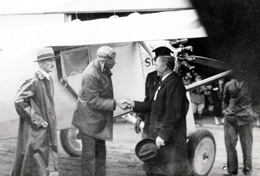By 1920, at the instigation of the Chamber of Commerce, the City of Spokane has designated the Parkwater Aviation Field as its municipal airport. Since 1913, aviators have been using the city-owned stretch of land east of town along the south bank of the Spokane River for flying activities. Gradually Parkwater became more popular for commercial, recreational, and military use than rival airfields in the Spokane area and is heavily used beginning in 1919. In 1926, the United States Department of Commerce will designate Parkwater as an airport. In 1927, it will be renamed Felts Field, which will remain the Spokane Municipal Airport, whereas the Spokane International Airport will be located west of the city.
A Rural Valley
Parkwater was a district in the then largely rural valley stretching from the eastern boundary of Spokane to the Idaho border. At first the airstrip there was referred to as "a field out by Parkwater" (McGoldrick, 17) indicating its general location; soon it was called the Parkwater Aviation Field, or simply Parkwater. Although aviation activities at Parkwater began in 1913, most of Spokane’s early aviators and exhibition flyers from elsewhere also continued to use other informal airstrips such as the fairgrounds east of the city and the smaller and more dangerous Glover Athletic Field along the Spokane River at the west end of downtown. Regarding the madly popular “flying circuses” staged there, the Spokane Daily Chronicle reported on April 21, 1919:
“Because of hazards both to spectators and aviators the War Department has ordered that the flying circus must discontinue staging its exhibitions and stunts directly over municipalities. ... The flying circus management therefore announced that the exhibition which will be given by the planes Wednesday will take place directly over Parkwater” (McGoldrick, 34).
On June 14, 1919, the Spokane Chronicle announced that Miss Spokane, Marguerite Motie, had christened the first airplane built by the Northwest Aircraft Company of Spokane, naming it the Miss Spokane. This company had leased 1,000 acres at Parkwater from the Spokane Park Board with the intention of installing hangars and starting an airline service. By August, flying service at Parkwater was announced, and in September the Spokane Flying Club expressed the need for municipal safety regulations for the area.
Placed in Condition for Landing
By this time (1919), the newspapers were already referring to “the municipal flying field at Parkwater” (McGoldrick, 35), so there is some ambiguity as to the exact date of the official designation of Parkwater as the municipal airport. To further complicate matters, a rival, the Russell-Symons Airport (also called the Foster Russell Airport), was being developed on East Sprague, to the south of Parkwater. A May 3, 1920, headline announces “Spokane To Have Two Flying Fields,” and the article goes on to state:
“This city is to have two standard landing fields. The Russell-Symons Aviation Company’s ground has been standardized for six months and has been in daily use throughout the winter. ... The city’s Parkwater field ... is being placed in condition for landing under all conditions. This is the original flying field in Spokane and has been used by government flyers” (McGoldrick, 38).
Placing “in condition for landing” included the removal of stones, an ongoing effort. An article of May 24, 1920, declared that Parkwater had been cleared of stones and leveled off. However, as late as 1922 and 1923, Spokane jail inmates were being allowed “field exercise” for this purpose (McGoldrick, 39).
New Age of Air
James McGoldrick, an authority on Spokane aviation history, states:
“Jim Ford, longtime active manager of the Spokane Chamber of Commerce, mentioned in a brief historical paper in 1950 how, in 1920, Spokane had decided that it must have a municipal landing field. There were no such things as ‘airports’ at that time. As a result, the city commissioners and the park board set aside ... Parkwater, which at that time was a part of the city park area, so Spokane could have an air landing field. ... In 1926 the Department of Commerce officially recognized Spokane’s flying field and designated it as an airport. ... one of the first officially recognized airports in the United States” (McGoldrick, 50).
During the 1920s, Parkwater became the site of airplane construction and repair, charter service, flight instruction, and aerial photography. In 1925, a portion of Parkwater was designated headquarters for the 116th Observation Squadron of the Washington Air National Guard and named Camp Earl Hoisington (or Earl Hoisington Field). Parkwater also hosted a major air circus in 1925.
On September 12, Charles Lindbergh (1902-1974) landed his Spirit of St. Louis At Parkwater before moving on by limousine to the fairgrounds, which could better accommodate the huge crowds waiting to welcome him. The Parkwater era officially ended on the week of September 21, 1927, during the National Air Races, when it was dedicated as Felts Field in honor of Lt. James Buell Felts who had been killed in a crash there on May 29, 1927.

